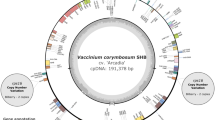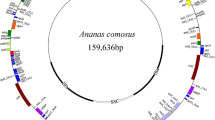Abstract
The complete plastid genome sequence of the American cranberry (Vaccinium macrocarpon Ait.) was reconstructed using next-generation sequencing data by in silico procedures. We used Roche 454 shotgun sequence data to isolate cranberry plastid-specific sequences of “HyRed” via homology comparisons with complete sequences from several species available at the National Center for Biotechnology Information database. Eleven cranberry plastid contigs were selected for the construction of the plastid genome-based homologies and on raw reads flowing through contigs and connection information. We assembled and annotated a cranberry plastid genome (82,284 reads; 185x coverage) with a length of 176 kb and the typical structure found in plants, but with several structural rearrangements in the large single-copy region when compared to other plastid asterid genomes. To evaluate the reliability of the sequence data, phylogenetic analysis of 30 species outside the order Ericales (with 54 genes) showed Vaccinium inside the clade Asteridae, as reported in other studies using single genes. The cranberry plastid genome sequence will allow the accumulation of critical data useful for breeding and a suite of other genetic studies.





Similar content being viewed by others
References
Altschul SF, Gish W, Miller W, Myers EW, Lipman DJ (1990) Basic local alignment search tool. J Mol Biol 215:403–410
Anderberg AA, Rydin C, Källerjö M (2002) Phylogenetic relationships in the order Ericales s.l.: analyses of molecular data from five genes from the plastid and mitochondrial genomes. American J Bot 89:677–687
Bruederle LP, Vorsa N (1994) Genetic differentiation of diploid blueberry, Vaccinium sect. Cyanococcus (Ericaceae). Syst Botany 19:337–349
Clarke JL, Daniell H (2011) Plastid biotechnology for crop production: present status and future perspectives. Plant Mol Biol 76:211–220
Darling AE, Mau B, Perna NT (2010) progressiveMauve: multiple genome alignment with gene gain, loss, and rearrangement. PLoS One 5(6):e11147
Eck P (1990) The American cranberry. Rutgers University Press, New Brunswick
Edgar RC (2004) MUSCLE: multiple sequence alignment with high accuracy and high throughput. Nucleic Acids Res 32:1792–1797
Fazekas AJ, Burgess KS, Kesanakurti PR, Graham SW, Newmaster SG, Husband BC, Percy DM, Hajibabaei M, Barrett SCH (2008) Multiple multilocus DNA barcodes from the plastid genome discriminate plant species equally well. PLoS One 3:e2802
Galmes J, Flexas J, Keys AJ, Cifre J, Mitchell RAC, Madgwick PJ, Haslam RP, Medrano H, Parry MAJ (2005) Rubisco specificity factor tends to be larger in plant species from drier habitats and in species with persistent leaves. Plant Cell Environ 28:571–579
Hikosaka K, Shigeno A (2009) The role of Rubisco and cell walls for the interspecific variation in photosynthetic capacity. Oecologia 160:443–451
Iorizzo M, Senalik D, Szklarczyk M, Grzebelus D, Spooner S, Simon P (2012) De novo assembly of the carrot mitochondrial genome using next generation sequencing of whole genomic DNA provides first evidence of DNA transfer into an angiosperm plastid genome. BMC Plant Biol 12:61
Jansen RK, Saski C, Lee S, Hansen AK, Daniell H (2011) Complete plastid genome sequences of three rosids (Castanea, Prunus, Theobroma): evidence for at least two independent transfers of rpl22 to the nucleus. Mol Biol Evol 28:835–847
Kalt W (2002) Health functional phytochemicals of fruits. Hortic Rev 27:269–315
Kron KA, Chase MW (1993) Systematics of the Ericaceae, Empetraceae, Epacridaceae and related taxa based upon rbcL sequence data. Ann Mo Bot Gard 80:735–741
Kron KA, Judd WS (1997) Systematics of the Lyonia group (Andromedeae, Ericaceae) and the use of species as terminals in higher-level cladistic analyses. Syst Bot 22:479–492
Kron KA, Judd WS, Stevens PF, Crayn DM, Anderberg AA, Gadek PA, Quinn CJ, Luteyn JL (2002) Phylogenic classification of Ericaceae: molecular and morphological evidence. Bot Rev 68:335–423
Kumudini S (2004) Effects of radiation and temperature on cranberry photosynthesis and characterization of diurnal variation in photosynthesis. J Amer Soc Hort Sci 129:106–111
Kurtz S, Phillippy A, Delcher AL, Smoot M, Shumway M, Antonescu C, Salzberg SL (2004) Versatile and open software for comparing large genomes. Genome Biol 5:R12
Maliga P, Svab Z (2011) Engineering the plastid genome of Nicotiana sylvestris, a diploid model species for plastid genetics. Plant Chromosom Eng: Met Protoc 701:37–50
Martins WS, Lucas DCS, Neves KFS, Bertioli DJ (2009) WebSat—a web software for microsatellite marker development. Bioinformation 3:282–283
McCown BH, Zeldin EL (2003) ‘HyRed’ and early, high fruit color cranberry hybrid. Hortscience 38:304–305
Nock CJ, Waters DL, Edwards MA, Bowen SG, Rice N, Cordeiro GM, Henry RJ (2011) Chloroplast genome sequences from total DNA for plant identification. Plant Biotechnol J 9:328–333
Posada D, Crandall KA (1998) Modeltest: testing the model of DNA substitution. Bioinformatics 14:817–818
Rivas JDL (2002) Comparative analysis of chloroplast genomes: functional annotation, genome-based phylogeny, and deduced evolutionary patterns. Genome Res 12:567–583
Schönenberger J, von Balthazar M, Sytsma KJ (2010) Diversity and evolution of floral structure among early diverging lineages in the Ericales. Phil Trans R Soc B 365:437–448
Stamatakis A, Hoover P, Rougemont J (2008) A rapid bootstrap algorithm for the RAxML web-servers. Syst Biol 57:758–771
Stevens PF (2001) Angiosperm phylogeny website. Version 9 June 2008. http://www.mobot.org/MOBOT/research/APweb/
Sugiura M (1992) The chloroplast genome. Plant Mol Biol 19:149–168
Sugiura M (1995) The chloroplast genome. Essays Biochem 30:49–57
Tangphatsornruang S, Sangsrakru D, Chanprasert J, Uthaipaisanwong P, Yoocha T, Jomchai N, Tragoonrung S (2010) The chloroplast genome sequence of mungbean (Vigna radiata) determined by high-throughput pyrosequencing: structural organization and phylogenetic relationships. DNA Res 17:11–22
Tesler G (2002) GRIMM: genome rearrangements web server. Bioinformatics 18:492–493
USDA-NASS (2011) Crop values 2011 summary. http://www.nass.usda.gov USDA-NASS, Washington, DC
Vander Kloet SP (1988) The genus Vaccinium in North America. Agr Canada Publ 1828:201
Wang W, Messing J (2011) High-throughput sequencing of three Lemnoideae (duckweeds) chloroplast genomes from total DNA. PLoS One 6:e24670
Wang SY, Stretch AW (2001) Antioxidant capacity in cranberry is influenced by cultivar and storage temperature. J Agr Food Chem 49:969–974
Wu CS, Lin CP, Hsu CY, Wang RJ, Chaw SM (2011) Comparative chloroplast genomes of Pinaceae: insights into the mechanism of diversified genomic organizations. Genome Biol Evol 3:309–319
Wyman SK, Jansen RK, Boore JL (2004) Automatic annotation of organellar genomes with DOGMA. Bioinformatics 20:3252–3255
Zalapa JE, Cuevas H, Steffan S, Zhu H, Senalik D, Zeldin E, McCown B, Harbut R, Simon P (2012) Using next generation sequencing approaches for the isolation of simple sequence repeats (SSR) in the plant sciences. Am J Bot 99:193–208
Zhu H, Senalik D, McCown BH, Zeldin EL, Speers J, Hyman J, Bassil N, Hummer K, Simon PW, Zalapa JE (2012) Mining and validation of pyrosequenced simple sequence repeats (SSRs) from American cranberry (Vaccinium macrocarpon Ait.). Theor Appl Genet 124:87–96
Acknowledgments
The authors thank PS100, Emily Gustin, P. Simon, and M. Iorizzo for their help with different aspects of this work. Eric Zeldin and Brent McCown provided the “HyRed” DNA. This research was supported by funds from the National Foundation Science (DBI-1228280), Wisconsin Cranberry Growers Association, and USDA-ARS (project no. 3655-21220-001-00), provided to J.E.Z., S.A.S., and R.H.
Data archiving statement
The accession number JQ_757046 was assigned to the complete cranberry plastid genome sequence after being submitted to NCBI.
Author information
Authors and Affiliations
Corresponding author
Additional information
Communicated by W. Guo
Data archiving statement
The accession number JQ_757046 was assigned to the complete cranberry plastid genome sequence after being submitted to NCBI.
Rights and permissions
About this article
Cite this article
Fajardo, D., Senalik, D., Ames, M. et al. Complete plastid genome sequence of Vaccinium macrocarpon: structure, gene content, and rearrangements revealed by next generation sequencing. Tree Genetics & Genomes 9, 489–498 (2013). https://doi.org/10.1007/s11295-012-0573-9
Received:
Revised:
Accepted:
Published:
Issue Date:
DOI: https://doi.org/10.1007/s11295-012-0573-9




